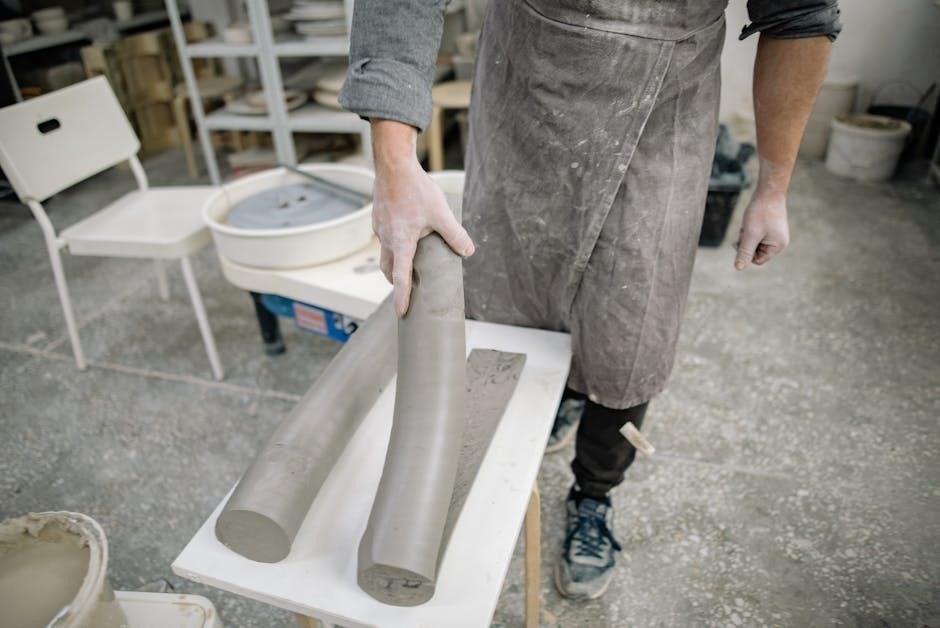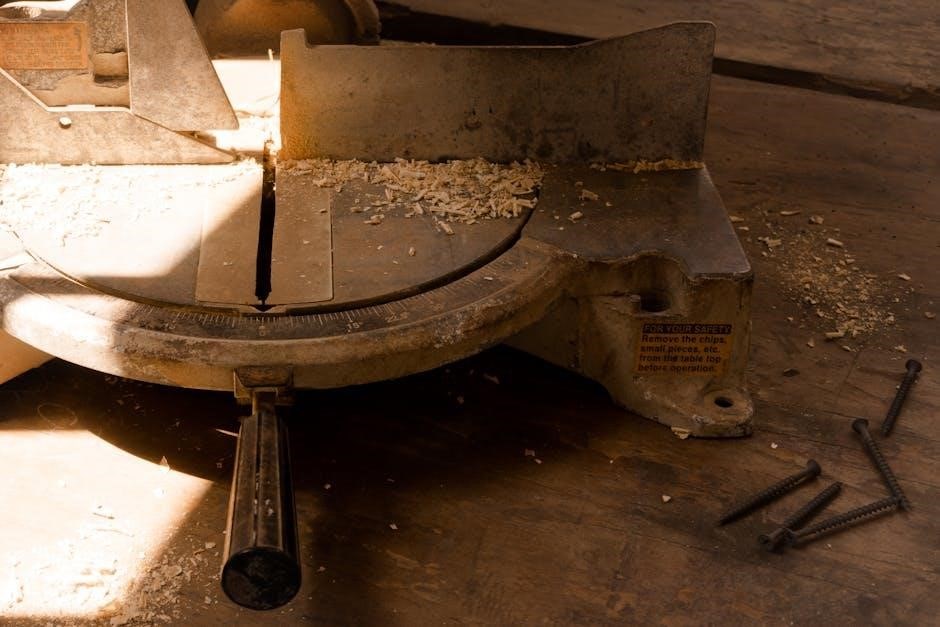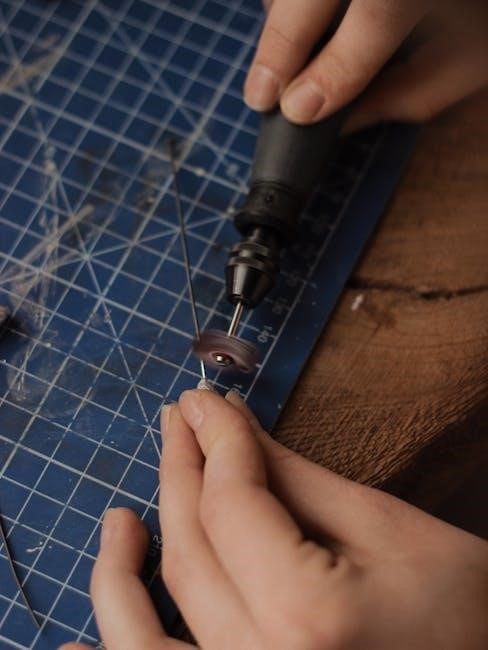Manual surface grinders are essential tools for achieving precise, flat, and smooth surfaces on metal workpieces. They are versatile machines used across various industries for grinding, finishing, and polishing operations, offering high accuracy and control.
1.1 Definition and Purpose
A manual surface grinder is a machine tool used to grind and finish surfaces of metal workpieces. It employs an abrasive wheel to remove material, ensuring precise, flat, and smooth surfaces. Primarily designed for high-precision tasks, these grinders are essential in metalworking, toolmaking, and other industries requiring accurate surface finishing. Operators manually control table movement and grinding depth to achieve desired results.
1.2 Brief History and Evolution
The manual surface grinder traces its origins to early 20th-century mechanical advancements. Initially developed for basic grinding tasks, it evolved to incorporate precision features like linear ball bearings and hardened guideways. Modern models, such as the Chevalier FSG-818SP, offer enhanced rigidity and superior finish capabilities, reflecting ongoing innovations in materials and design. This evolution has maintained their relevance in precise metalworking applications.

Key Features of Manual Surface Grinders
Manual surface grinders feature robust table sizes, precise linear ball bearings, and advanced lubrication systems. Models like the Chevalier FSG-818SP offer rigid construction for high-precision grinding.
2.1 Table Size and Capacity
Manual surface grinders are available in various table sizes, ranging from compact 6×12 inches to larger 32×80 inches. Their capacity ensures efficient processing of workpieces, from small parts in toolrooms to heavy-duty industrial applications. Models like the SG-618 and SG-820-2A offer robust tables designed for stability, ensuring precise grinding operations across different material sizes and thicknesses.
2.2 Lubrication Systems
Manual surface grinders often feature robust lubrication systems to ensure smooth operation and longevity. Willis grinders use a one-shot lube system, while automatic models employ continuous lubrication for moving parts. Proper lubrication enhances table movement precision and prevents wear, ensuring optimal grinding performance across various industrial applications. Regular maintenance of these systems is crucial for sustained machine efficiency.
2.3 Table Movement Mechanisms
Manual surface grinders utilize advanced table movement mechanisms for precise control. Sharps models feature steel core wire rope drives, ensuring smooth operation and surface-to-surface contact for better weight distribution. Hydraulic systems and motorized vertical movements enhance flexibility, while linear ball bearings and hardened guideways provide stability. These mechanisms allow operators to achieve consistent and accurate grinding results across various applications.

Types of Manual Surface Grinders
Manual surface grinders come in compact models for small workspaces and heavy-duty versions for industrial use, catering to diverse applications and precision requirements.
3.1 Compact Models for Small Workspaces
Compact manual surface grinders are ideal for small shops and toolrooms, offering precision and efficiency in limited spaces. These models, like the 6×12 grinder, provide features similar to larger machines, enabling high-accuracy grinding and mirror-like finishes on metalwork. Their compact design ensures versatility while maintaining performance, making them a practical choice for detailed projects.
3.2 Heavy-Duty Models for Industrial Use
Heavy-duty manual surface grinders are designed for demanding industrial applications, offering robust construction and high precision. Models like the Chevalier FSG-818SP and Clausing grinders feature rigid frames and advanced lubrication systems, ensuring durability and accuracy. These machines excel in large-scale grinding tasks, such as processing machine bases and die-mold components, making them indispensable for heavy-duty industrial operations.
Applications of Manual Surface Grinders
Manual surface grinders are widely used in metalworking and toolmaking for precision grinding. They are ideal for processing die-mold components, machinery parts, and achieving high surface finishes.
4.1 Metalworking and Toolmaking
Manual surface grinders are pivotal in metalworking and toolmaking for precision grinding of tools and components. They ensure accurate flatness and finish on dies, molds, and machine parts. Operators control the feed rate and depth, making them ideal for intricate tasks requiring high tolerance. These grinders are essential for maintaining tool longevity and performance in demanding industrial environments.
4.2 Precision Grinding in Various Industries
Manual surface grinders are widely used across industries like aerospace, automotive, and electronics for precision grinding. They enable the achievement of tight tolerances and mirror-like finishes on components. Their versatility makes them ideal for grinding small to medium-sized parts, ensuring high accuracy and surface quality. This makes them indispensable in sectors requiring precise dimensional control and superior surface finishes.
Grinding Capacity and Precision
Manual surface grinders balance high grinding capacity with precise material removal, enabling both efficient metalworking and achieving smooth, mirror-like finishes on various materials.
5.1 Maximum Material Removal Rates
Manual surface grinders offer varying grinding capacities, from compact 6×18 models to large 32×80 tables, enabling efficient material removal for diverse industrial needs. Advanced designs, such as steel core wire rope drives, ensure smooth operation and consistent results. Proper setup and techniques allow operators to maximize removal rates while maintaining precision and surface quality across different workpiece sizes and materials.
5.2 Achieving Mirror-Like Finishes
Manual surface grinders excel at producing high-luster, mirror-like finishes by using precise grinding wheels and controlled operations. Skilled operators can achieve exceptional surface quality through multiple passes, adjusting feed rates, and using optimal grinding techniques. Advanced models, such as the Chevalier FSG-818SP, are designed for super precision, ensuring flawless finishes even on intricate workpieces, making them ideal for demanding industrial applications.

Manual Operation and Control
Manual surface grinders require skilled operators to control the X and Y axis movements, ensuring precise grinding. The table height adjusts for accurate material removal, offering superior control over the process.
6.1 X and Y Axis Table Movement
Manual surface grinders feature X and Y axis table movements controlled by operators. The X-axis handle moves the table horizontally, while the Y-axis handle adjusts the vertical position. This dual control enables precise alignment and positioning of workpieces, ensuring accurate grinding operations. Smooth table movement is essential for achieving high-precision finishes and maintaining consistent material removal rates.
6.2 Adjusting the Grinding Depth
Adjusting the grinding depth on manual surface grinders ensures precise material removal. Operators typically set the depth using a vertical handle or adjustment mechanism, allowing for controlled feed rates. This feature enables users to achieve the desired finish, from rough grinding to mirror-like surfaces, by maintaining consistent and accurate depth settings throughout the grinding process.

Maintenance and Care
Regular lubrication of moving parts is crucial for manual surface grinders to ensure smooth operation and extend machine life. Proper maintenance also involves cleaning and inspecting components.
7.1 Lubrication of Moving Parts
Proper lubrication is essential for maintaining the performance and longevity of manual surface grinders. Regular application of high-quality machine oil ensures smooth operation of table movements and grinding spindles. Lubrication systems, such as one-shot lube or automatic systems, prevent wear and tear on critical components. Operators should follow manufacturer guidelines for lubricant type and application frequency to maintain precision and functionality.
7.2 Cleaning and Dust Removal
Regular cleaning and dust removal are crucial for maintaining the accuracy and efficiency of manual surface grinders. Dust and debris can interfere with grinding operations, so operators must use compressed air, brushes, or vacuum systems to keep surfaces clean. Additionally, magnetic chuck surfaces should be wiped down to ensure proper workpiece adhesion, preventing contamination and ensuring optimal grinding results consistently.

Safety Considerations
Proper handling and protective gear are essential when operating manual surface grinders. Always wear safety goggles and gloves to prevent injuries from flying particles. Ensure the workspace is well-lit and free from obstructions for safe operation. Regularly inspect the machine and accessories to maintain optimal working conditions and minimize risks.
8.1 Proper Handling Techniques
Proper handling techniques are crucial for safe and effective operation of manual surface grinders. Operators should maintain a secure grip on the handles to guide the workpiece smoothly across the grinding wheel. Applying steady, controlled pressure ensures even material removal and prevents vibrations. Always use jigs or fixtures to hold workpieces firmly in place, reducing the risk of accidents. Keep loose clothing tied back and avoid overreaching. Proper posture prevents fatigue and maintains control during grinding operations.
8.2 Protective Gear and Workspace Setup
Protective gear is essential for safe operation of manual surface grinders. Always wear safety glasses, gloves, and a face mask to shield against flying particles and dust. Ensure the workspace is well-ventilated and free from clutter to prevent accidents. The grinder should be placed on a stable, level surface, and loose clothing or jewelry should be secured; Proper workspace setup minimizes hazards and enhances productivity.

Comparison with Automatic Surface Grinders
Manual surface grinders offer precision and control for small-scale tasks, while automatic grinders excel in speed and efficiency for large-scale production, suiting different industrial needs.
9.1 Advantages of Manual Grinders
Manual surface grinders provide exceptional control for precise grinding operations, ideal for small workpieces and detailed tasks. They are cost-effective, require minimal setup, and offer portability, making them perfect for workshops with limited space. Their simplicity ensures lower maintenance compared to automatic grinders, while still delivering high accuracy and versatility in various applications.
9.2 Limitations Compared to Automatic Grinders
Manual surface grinders require operator intervention for feed rate and depth control, making them slower for large-scale production. They rely on operator skill, reducing consistency in high-volume tasks. Automatic grinders, by contrast, offer faster processing and higher throughput with minimal human intervention, making manual grinders less efficient for industrial-scale applications requiring rapid and consistent output.

Popular Brands and Models
Prominent brands like Chevalier, Clausing, and Mitsui High-Tec offer high-quality manual surface grinders. Models such as the FSG-818SP, SG-618, and CSG618H are renowned for their precision and reliability.
10.1 Chevalier and Clausing Models
Chevalier’s FSG-818SP is a high-precision manual surface grinder with a rigid construction and linear ball bearings for smooth operation. Clausing’s CSG618H offers a 6×18 table size with manual X, Y, and Z travel, ideal for precise control. Both brands are trusted for their durability and accuracy, making them popular choices in metalworking and toolmaking industries.
10.2 Mitsui High-Tec and Other Manufacturers
Mitsui High-Tec offers high-precision manual and automatic surface grinders, along with grinder parts and precision tools. Known for quality and reliability, their grinders are popular in metalworking. Other manufacturers like Enco and Grizzly provide affordable manual grinders with features like 6×12 tables and 3,450 RPM, ideal for small shops and precise finishes. These brands ensure durability and performance for various industrial needs.


